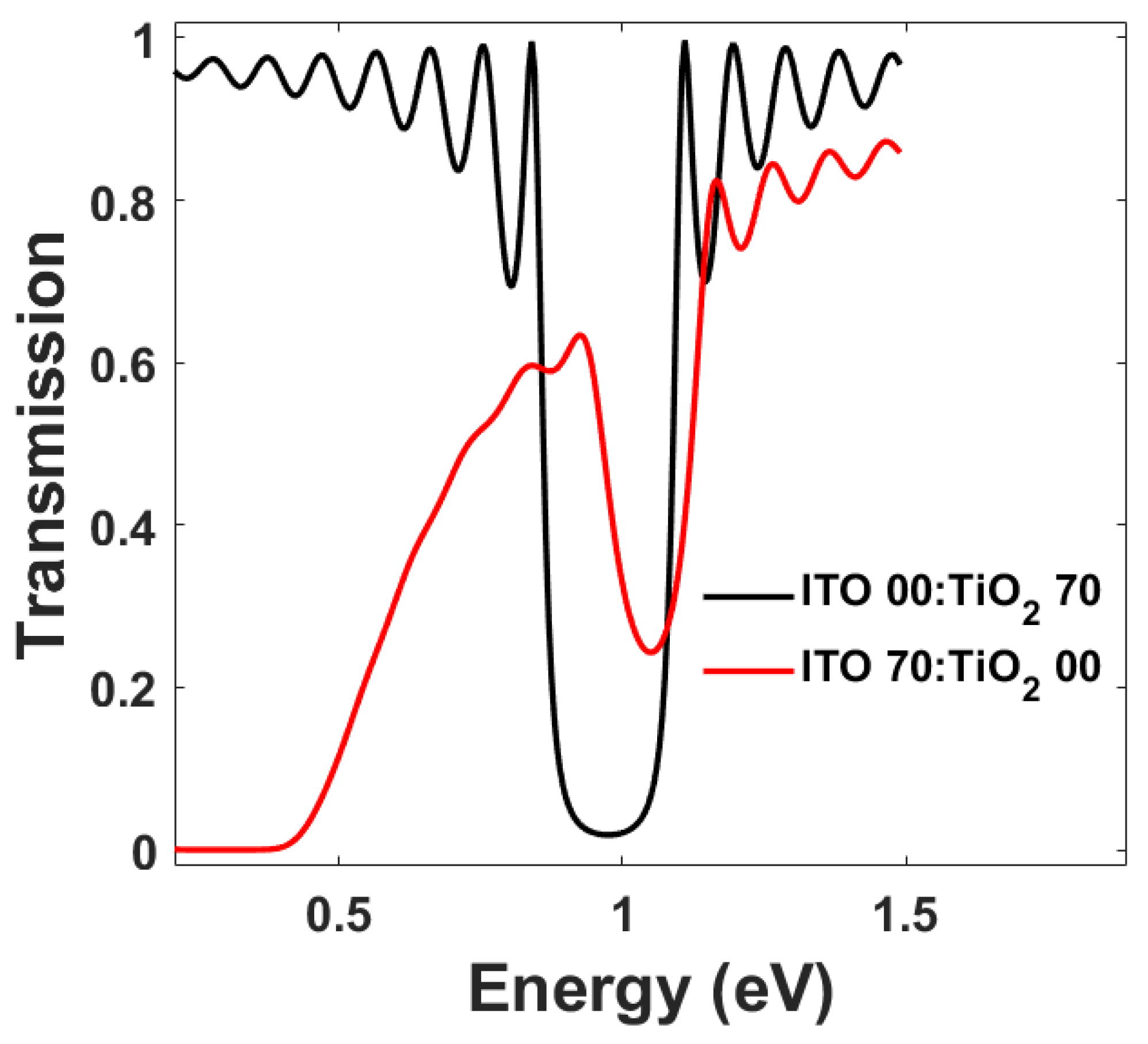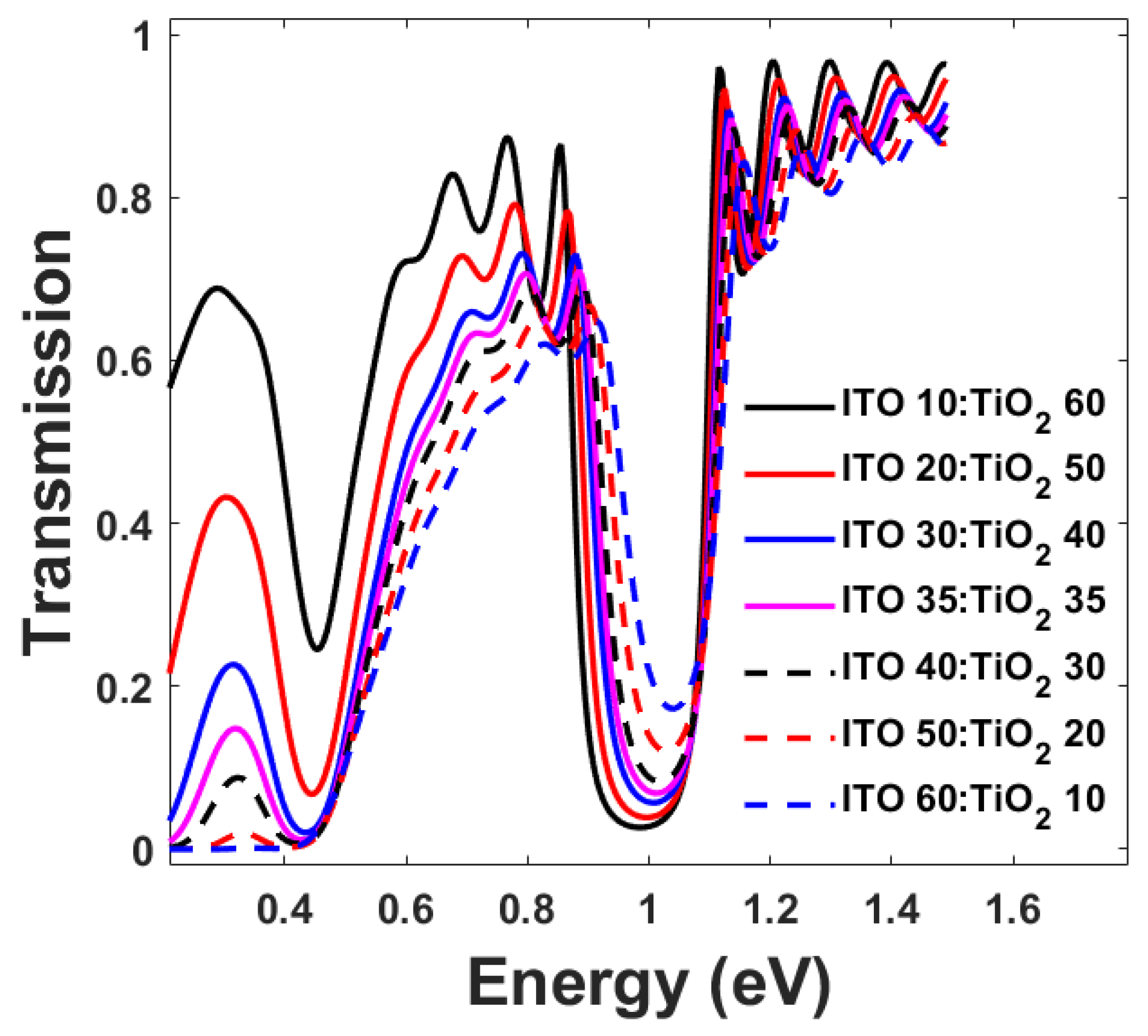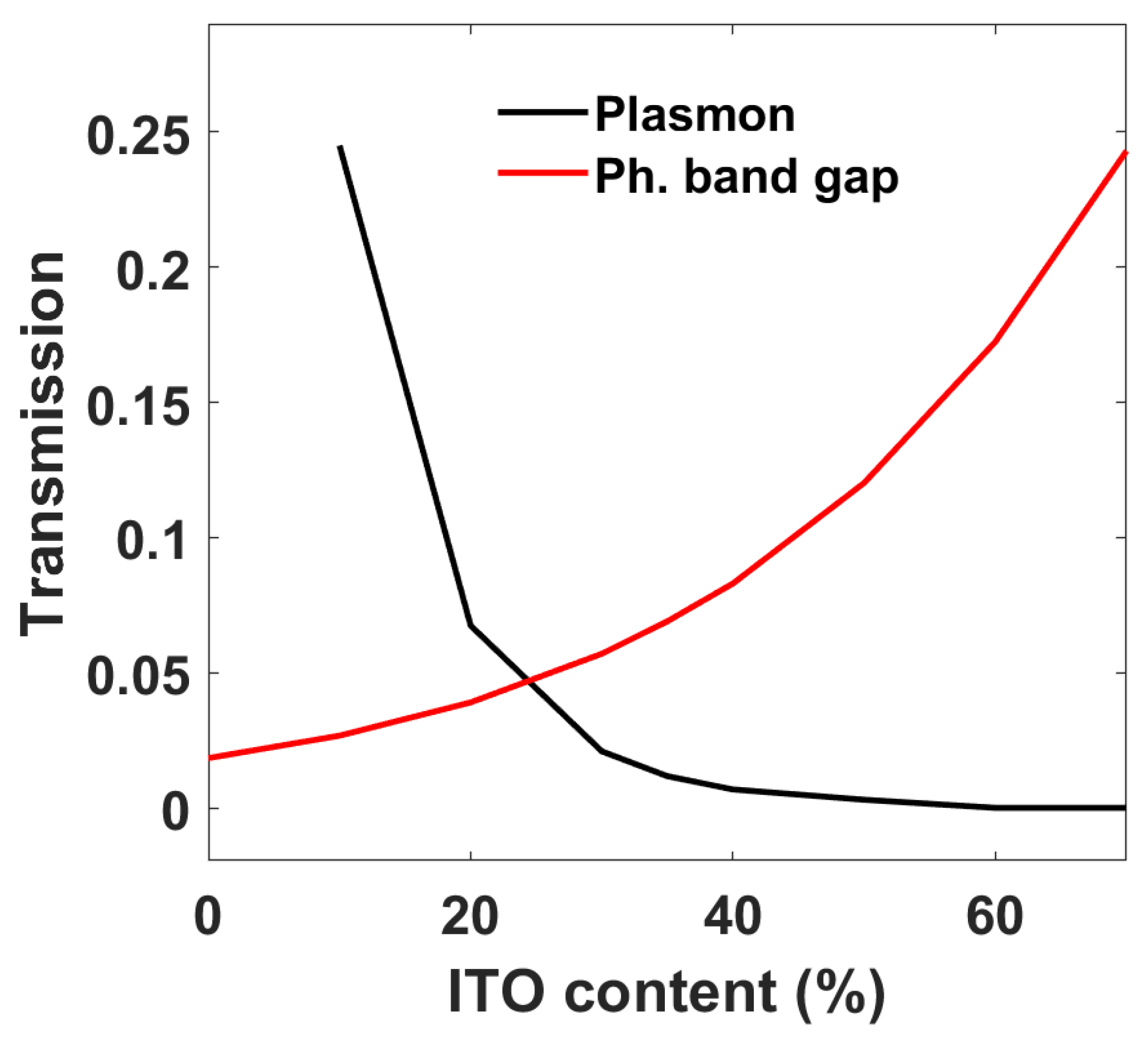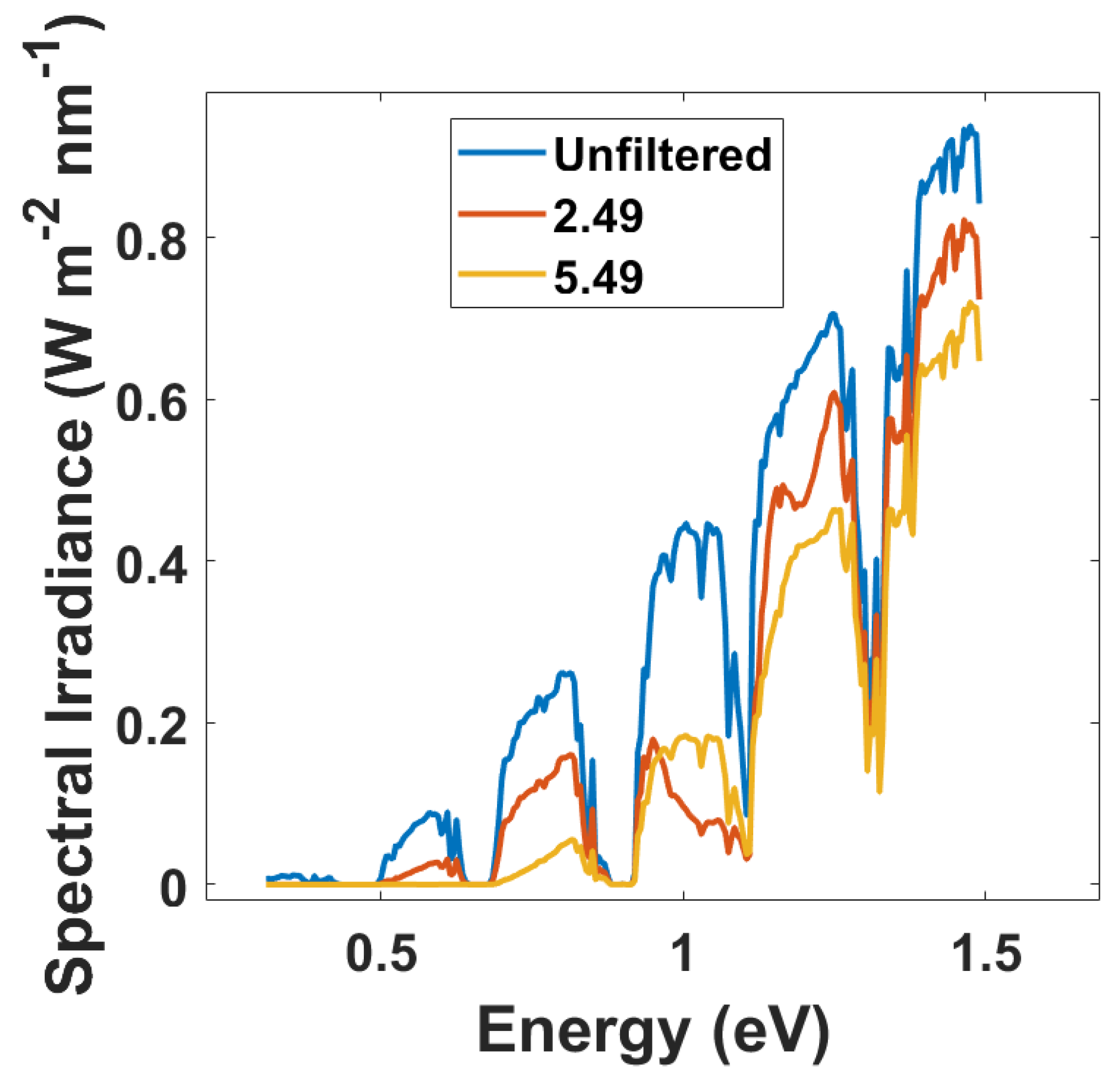Indium Tin Oxide Nanoparticle: TiO2: Air Layers for One-Dimensional Multilayer Photonic Structures
Abstract
1. Introduction
2. Methods
2.1. ITO:TiO2:Air Layer Refractive Index
2.2. SiO2:Air Layer Refractive Index
2.3. Transmission of the Multilayer Photonic Crystal
3. Results and Discussion
4. Conclusions
Author Contributions
Funding
Conflicts of Interest
References
- von Freymann, G.; Kitaev, V.; Lotsch, B.V.; Ozin, G.A. Bottom-up assembly of photonic crystals. Chem. Soc. Rev. 2013, 42, 2528–2554. [Google Scholar] [CrossRef] [PubMed]
- Lova, P.; Manfredi, G.; Comoretto, D. Advances in Functional Solution Processed Planar 1D Photonic Crystals. Adv. Opt. Mater. 2018, 6, 1800730. [Google Scholar] [CrossRef]
- Chiasera, A.; Tosello, C.; Moser, E.; Montagna, M.; Belli, R.; Gonçalves, R.R.; Righini, G.C.; Pelli, S.; Chiappini, A.; Zampedri, L.; et al. Er3+/Yb3+-activated silica–titania planar waveguides for EDPWAs fabricated by rf-sputtering. J. Non-Cryst. Solids 2003, 322, 289–294. [Google Scholar] [CrossRef]
- John, S. Strong localization of photons in certain disordered dielectric superlattices. Phys. Rev. Lett. 1987, 58, 2486–2489. [Google Scholar] [CrossRef] [PubMed]
- Yablonovitch, E. Inhibited Spontaneous Emission in Solid-State Physics and Electronics. Phys. Rev. Lett. 1987, 58, 2059–2062. [Google Scholar] [CrossRef] [PubMed]
- Joannopoulos, J.D. Photonic Crystals: Molding the Flow of Light; Princeton University Press: Princeton, NJ, USA, 2008. [Google Scholar]
- Nucara, L.; Greco, F.; Mattoli, V. Electrically responsive photonic crystals: A review. J. Mater. Chem. C 2015, 3, 8449–8467. [Google Scholar] [CrossRef]
- Bellingeri, M.; Chiasera, A.; Kriegel, I.; Scotognella, F. Optical properties of periodic, quasi-periodic, and disordered one-dimensional photonic structures. Opt. Mater. 2017, 72, 403–421. [Google Scholar] [CrossRef]
- Kriegel, I.; Scotognella, F.; Manna, L. Plasmonic doped semiconductor nanocrystals: Properties, fabrication, applications and perspectives. Phys. Rep. 2017, 674, 1–52. [Google Scholar] [CrossRef]
- Naik, G.V.; Shalaev, V.M.; Boltasseva, A. Alternative Plasmonic Materials: Beyond Gold and Silver. Adv. Mater. 2013, 25, 3264–3294. [Google Scholar] [CrossRef]
- Pedroni, M.; Canetti, M.; Chiarello, G.L.; Cremona, A.; Inzoli, F.; Luzzati, S.; Pietralunga, S.M.; Tagliaferri, A.; Zani, M.; Vassallo, E.; et al. Tungsten oxide thin film photo-anodes by reactive RF diode sputtering. Thin Solid Film. 2016, 616, 375–380. [Google Scholar] [CrossRef]
- Feigenbaum, E.; Diest, K.; Atwater, H.A. Unity-Order Index Change in Transparent Conducting Oxides at Visible Frequencies. Nano Lett. 2010, 10, 2111–2116. [Google Scholar] [CrossRef] [PubMed]
- Agrawal, A.; Kriegel, I.; Runnerstrom, E.L.; Scotognella, F.; Llordes, A.; Milliron, D.J. Rationalizing the Impact of Surface Depletion on Electrochemical Modulation of Plasmon Resonance Absorption in Metal Oxide Nanocrystals. ACS Photonics 2018, 5, 2044–2050. [Google Scholar] [CrossRef]
- Kriegel, I.; Scotognella, F. Tunable light filtering by a Bragg mirror/heavily doped semiconducting nanocrystal composite. Beilstein J. Nanotechnol. 2015, 6, 193–200. [Google Scholar] [CrossRef] [PubMed]
- Guduru, S.S.K.; Kriegel, I.; Ramponi, R.; Scotognella, F. Plasmonic Heavily-Doped Semiconductor Nanocrystal Dielectrics: Making Static Photonic Crystals Dynamic. J. Phys. Chem. C 2015, 119, 2775–2782. [Google Scholar] [CrossRef]
- Llordés, A.; Garcia, G.; Gazquez, J.; Milliron, D.J. Tunable near-infrared and visible-light transmittance in nanocrystal-in-glass composites. Nature 2013, 500, 323–326. [Google Scholar] [CrossRef]
- Müller, J.; Sönnichsen, C.; von Poschinger, H.; von Plessen, G.; Klar, T.A.; Feldmann, J. Electrically controlled light scattering with single metal nanoparticles. Appl. Phys. Lett. 2002, 81, 171–173. [Google Scholar] [CrossRef]
- Lounis, S.D.; Runnerstrom, E.L.; Bergerud, A.; Nordlund, D.; Milliron, D.J. Influence of Dopant Distribution on the Plasmonic Properties of Indium Tin Oxide Nanocrystals. J. Am. Chem. Soc. 2014, 136, 7110–7116. [Google Scholar] [CrossRef]
- Mendelsberg, R.J.; Garcia, G.; Li, H.; Manna, L.; Milliron, D.J. Understanding the Plasmon Resonance in Ensembles of Degenerately Doped Semiconductor Nanocrystals. J. Phys. Chem. C 2012, 116, 12226–12231. [Google Scholar] [CrossRef]
- Scotognella, F.; Chiasera, A.; Criante, L.; Aluicio-Sarduy, E.; Varas, S.; Pelli, S.; Łukowiak, A.; Righini, G.C.; Ramponi, R.; Ferrari, M.; et al. Metal oxide one dimensional photonic crystals made by RF sputtering and spin coating. Ceram. Int. 2015, 41, 8655–8659. [Google Scholar] [CrossRef]
- Sihvola, A.; Lindell, I.V. Polarizability and Effective Permittivity of Layered and Continuously Inhomogeneous Dielectric Spheres. J. Electromagn. Waves Appl. 1989, 3, 37–60. [Google Scholar] [CrossRef]
- Malitson, I.H. Interspecimen Comparison of the Refractive Index of Fused Silica. J. Opt. Soc. Am. 1965, 55, 1205–1208. [Google Scholar] [CrossRef]
- Niklasson, G.A.; Granqvist, C.G. Optical properties and solar selectivity of coevaporated Co-Al2O3 composite films. J. Appl. Phys. 1984, 55, 3382–3410. [Google Scholar] [CrossRef]
- Smith, G.B.; Niklasson, G.A.; Svensson, J.S.E.M.; Granqvist, C.G. Noble-metal-based transparent infrared reflectors: Experiments and theoretical analyses for very thin gold films. J. Appl. Phys. 1986, 59, 571–581. [Google Scholar] [CrossRef]
- Scotognella, F.; Puzzo, D.P.; Monguzzi, A.; Wiersma, D.S.; Maschke, D.; Tubino, R.; Ozin, G.A. Nanoparticle One-Dimensional Photonic-Crystal Dye Laser. Small 2009, 5, 2048–2052. [Google Scholar] [CrossRef] [PubMed]
- Born, M.; Wolf, E. Principles of Optics: Electromagnetic Theory of Propagation, Interference and Diffraction of Light; Cambridge University Press: Cambridge, UK, 2000. [Google Scholar]
- Xiao, X.; Wenjun, W.; Shuhong, L.; Wanquan, Z.; Dong, Z.; Qianqian, D.; Xuexi, G.; Bingyuan, Z. Investigation of defect modes with Al2O3 and TiO2 in one-dimensional photonic crystals. Optik 2016, 127, 135–138. [Google Scholar] [CrossRef]
- Paternò, G.M.; Iseppon, C.; D’Altri, A.; Fasanotti, C.; Merati, G.; Randi, M.; Desii, A.; Pogna, E.A.A.; Viola, D.; Cerullo, G.; et al. Solution Processable and Optically Switchable 1D Photonic Structures. ArXiv171103192 Cond-Mat Physicsphysics. Available online: http://arxiv.org/abs/1711.03192 (accessed on 5 December 2017).
- Solar Spectral Irradiance: Air Mass 1.5, (n.d.). Available online: http://rredc.nrel.gov/solar/spectra/am1.5/ (accessed on 14 February 2018).
- Clavero, C. Plasmon-induced hot-electron generation at nanoparticle/metal-oxide interfaces for photovoltaic and photocatalytic devices. Nat. Photonics 2014, 8, 95–103. [Google Scholar] [CrossRef]
- Leenheer, A.J.; Narang, P.; Lewis, N.S.; Atwater, H.A. Solar energy conversion via hot electron internal photoemission in metallic nanostructures: Efficiency estimates. J. Appl. Phys. 2014, 115, 134301. [Google Scholar] [CrossRef]






© 2019 by the authors. Licensee MDPI, Basel, Switzerland. This article is an open access article distributed under the terms and conditions of the Creative Commons Attribution (CC BY) license (http://creativecommons.org/licenses/by/4.0/).
Share and Cite
Kriegel, I.; Scotognella, F. Indium Tin Oxide Nanoparticle: TiO2: Air Layers for One-Dimensional Multilayer Photonic Structures. Appl. Sci. 2019, 9, 2564. https://doi.org/10.3390/app9122564
Kriegel I, Scotognella F. Indium Tin Oxide Nanoparticle: TiO2: Air Layers for One-Dimensional Multilayer Photonic Structures. Applied Sciences. 2019; 9(12):2564. https://doi.org/10.3390/app9122564
Chicago/Turabian StyleKriegel, Ilka, and Francesco Scotognella. 2019. "Indium Tin Oxide Nanoparticle: TiO2: Air Layers for One-Dimensional Multilayer Photonic Structures" Applied Sciences 9, no. 12: 2564. https://doi.org/10.3390/app9122564
APA StyleKriegel, I., & Scotognella, F. (2019). Indium Tin Oxide Nanoparticle: TiO2: Air Layers for One-Dimensional Multilayer Photonic Structures. Applied Sciences, 9(12), 2564. https://doi.org/10.3390/app9122564




